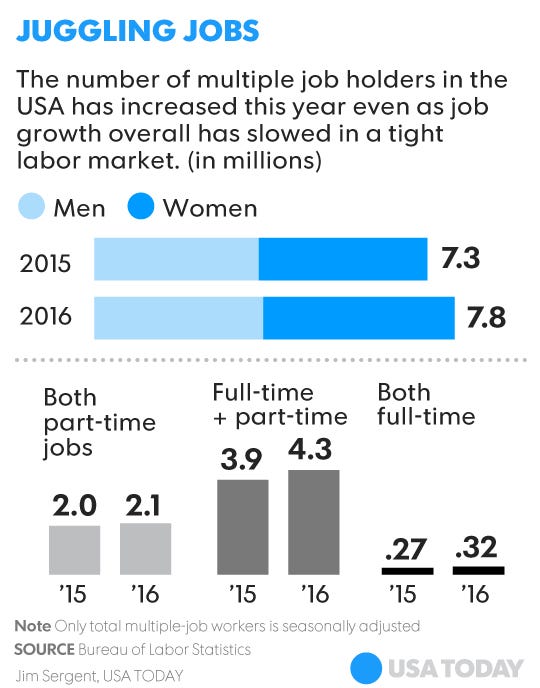The job juggle is real. Many Americans are balancing two, even three gigs

Many Americans who struggled to find a job several years ago are now juggling two or three.
The number of multiple job holders hit an eight-year high in September as several forces reshape the labor market. Many workers are seeking extra income as wages are inching up. Job openings are near record levels. And the burgeoning gig economy is putting a premium on freelance work and short-term projects.
Michael Alfaro, 49, of Coloma, Mich., toils full-time as an executive customer service representative for an appliance manufacturer. And on most evenings and some weekends, he works the late shift -- 6 PM to 10 PM or 4 PM to midnight -- in the electronics department of a local department store.
Alfaro decided to take the gig last November to whittle down about $37,000 in debt, including credit card, and student and personal loans. But he also was spurred by the struggles of area retailers and other businesses to find employees.
“It encouraged me,” he says.
The ranks of multiple job holders jumped by 300,000 last month to 7.8 million, according to the Bureau of Labor Statistics. The moonlighters represent 5.2% of all those employed, up from 4.9% in September 2015.
Monthly data can be volatile, but the totals through the first nine months of 2016 have averaged 7.5 million, nearly 300,000 higher than the year-ago figure.
“It’s symptomatic of a tight labor market and the fact that you have so many job openings,” says Mark Zandi, chief economist at Moody’s Analytics. “It means people who want to work are able to find jobs.”
Job openings neared an all-time high of 5.8 million in July before dropping to a still-healthy 5.4 million in August. Meanwhile, the near-normal 5% unemployment rate signifies the pool of available workers is limited. That’s a big reason total average monthly payroll growth has slowed to 178,000 this year from 229,000 in 2015.
Disappointing 156,000 jobs added in September

As a result, many frustrated employers are being more flexible and turning openings for full-time positions into multiple part-time slots.
“We are seeing an uptick in available part-time positions in general, likely due to the need to get additional staff on board, even if (job candidates) can’t make a full-time commitment,” says Amy Glaser, senior vice president of Adecco Staffing.
The crunch, she says, is especially acute for the holiday season. Employers are raising wages for part-time and seasonal positions “due to the need to secure top talent quickly,” she says.
Alfaro, a technology buff, says he doesn’t mind working as many as 68 hours a week, noting his part-time sales associate gig is starkly different from his desk job. “I get to interact with people, I get to walk around,” he says. “It’s kind of nice.”
The number of part-time workers who prefer that schedule hit a record high of 20.7 million last month, according to government data. That trend is largely a product of the “gig economy,” in which more workers are freelancing and doing contract work, often cobbling together part-time jobs. A report released last week by McKinsey Global Institute estimates these independent workers make up 20% to 30% of the working age population.
Many Americans still work part-time grudgingly
At the same time, some Americans are working multiple part-time gigs because they have no choice. Nearly 6 million such workers would prefer full-time jobs – a substantial decline from the 9 million in the recession and its aftermath, but still well above the prerecession level of about 4 million.
In recent years, many employers have been bringing on workers or contractors for part-time or temporary projects to cut costs. Others have shied away from hiring full-time workers to sidestep requirements to provide health care coverage under the Affordable Care Act.
And some full-time workers are taking on part-time gigs because their weekly income has fallen, says Tom Gimbel, CEO of LaSalle network, a Chicago staffing firm. Some employers, he says, are trying to avoid shelling out overtime pay ahead of a new rule that takes effect in December and will make millions of additional Americans eligible.